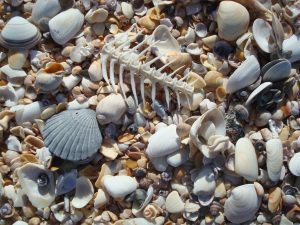Molluscan bioclasts are important components of tropical, and cool-temperate water limestones
Bioclasts are probably the most important components of Phanerozoic limestone frameworks (grainstones, rudstones, packstones, floatstones). They include all manner of invertebrates that produce preservable shells and skeletons, algae that secrete calcium carbonate structures (particularly red algae), and sponges that maintain their rigidity by growing an interlocking scaffolding of calcite or silica. Some are microscopic (e.g., foraminifera, radiolaria, sponge spicules), others are macroscopic. They may be preserved intact or as broken, abraded fragments. The most common macroscopic invertebrate representatives include molluscs, corals, echinoids, cirripedes (e.g., barnacles), bryozoans, and calcareous algae.
Shell structure
By far the largest group of shelly invertebrates is the molluscs, represented by bivalves, gastropods, ammonoids and nautiloids, scaphopods, and amphineura (e.g., chitons). All secrete shells that are layered in calcite or aragonite; each layer is monomineralic but the mineralogy can vary among layers. Many species also grow a chitinous outer layer, the periostracum, but this has low preservation potential. Bivalves commonly have 2 to 4 layers, gastropods up to 6 layers. Each layer consists of microscopic crystals oriented normal, parallel, or oblique to the shell surface. The most common crystal fabrics are:
- Prismatic, where high- or low-magnesium calcite or aragonite prisms are oriented normal to the shell surface. This is commonly the outer layer of a shell.
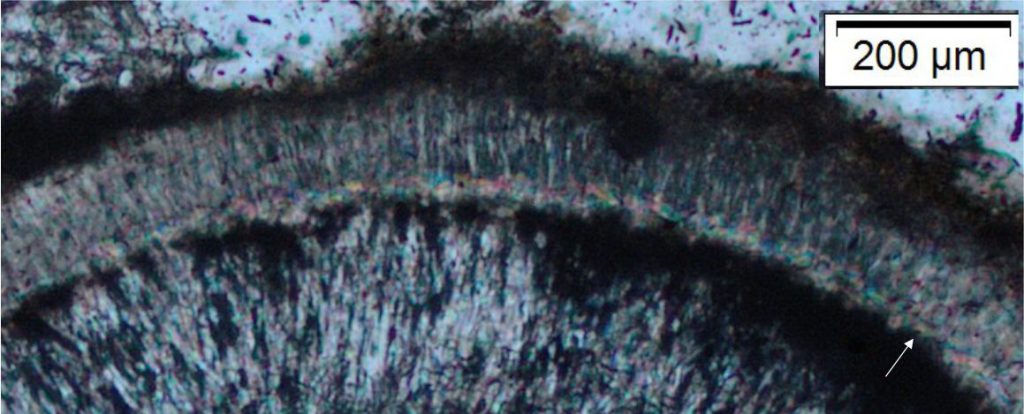
- Foliated, where micron-sized calcite crystal plates create a fabric that approximately parallels the shell surface.
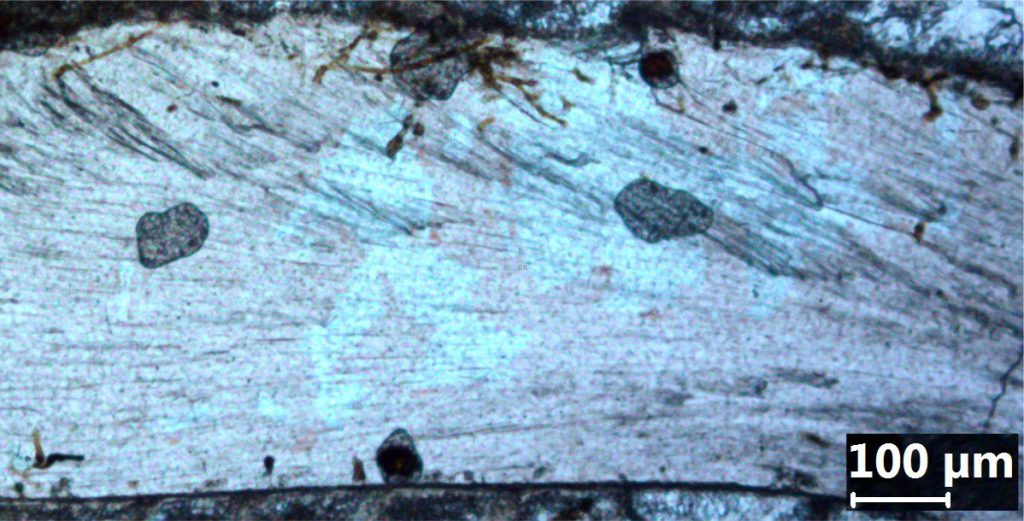
- Crossed lamellar structure where aragonite crystallites are organized in sheets. The crystallites in one sheet are oriented at relatively high angles to adjacent sheets. The overall effect can sometimes resemble a zig-zag pattern.
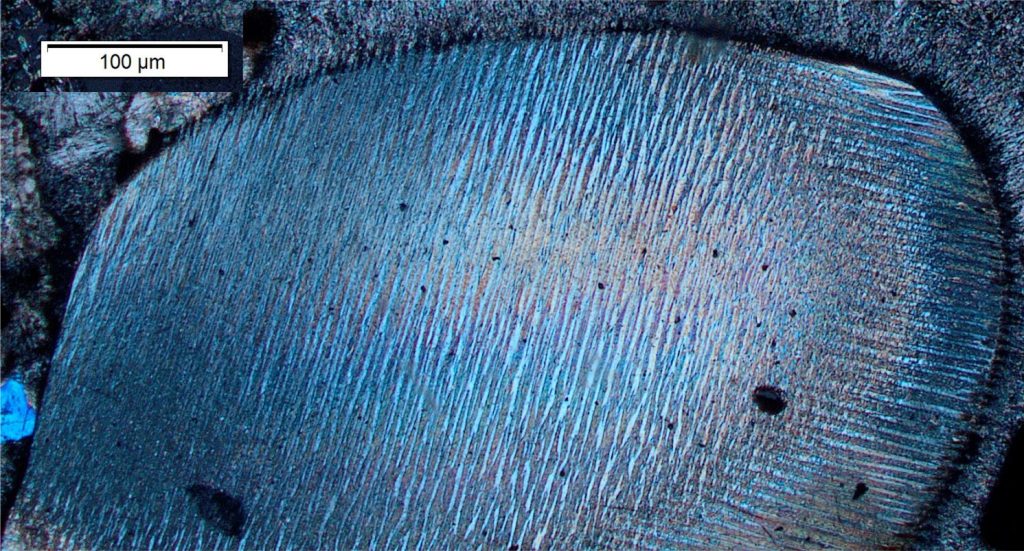
- Nacreous patterns of micron-sized aragonite plates arranged parallel to the surface – where this layer occurs on the inside of a shell, it is easily recognized by the lustrous, rainbow-like colours.
Most bivalves have two, three or four layers composed of calcite or aragonite, but there is much variation in structure depending on the species. For example, some species of the common mussel Mytilus contain a single, thick nacreous layer, whereas oysters (e.g., Ostrea) tend to consist of foliated calcite and a much thinner nacreous layer. Other species consist of combinations of layer types. Gastropods have up to 6 layers that in some species are all aragonite, and in others contain a thin layer of prismatic calcite. Scaphopods and cephalopods are composed entirely of aragonite.
Shells that contain aragonite are prone to recrystallization and replacement by sparry, low magnesium calcite. Mineral replacement usually destroys original crystal textures and may even obscure the distinction of individual layers, although traces of the former textures may persist. Examples of such textural changes are shown below.
Identification
Bioclasts are commonly fragmented. Fragment size is highly variable, depending on the original size of the critter, the degree of comminution resulting from bioerosion, and abrasion during transport and deposition, and to some extent diagenesis. In general, the larger the fragment, the easier the interpretation. However, there will be many fragments where even the phylum may be difficult to determine. Such problems are exacerbated by the (mostly) random orientation of a thin section slice through the bioclasts. The diagrams below show some of the characteristic morphological elements of mollusc shells that may help in this regard.
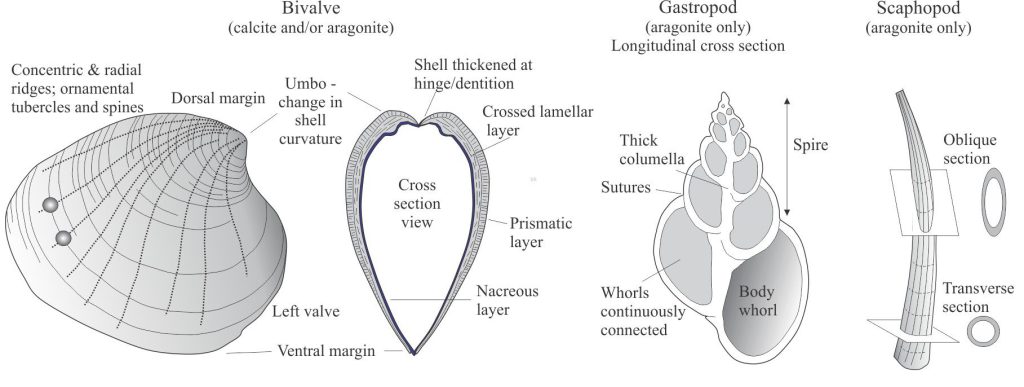
Bivalves
Non-chambered. A change in shell curvature from ventral to dorsal margins is most pronounced at the umbo, although this may not be apparent in some species such as oysters. The thickened hinge area between two valves is located just below the umbo; if you are really lucky there may be evidence of dentition (teeth and sockets). However, small fragments can be difficult to distinguish from gastropod or even brachiopod fragments.
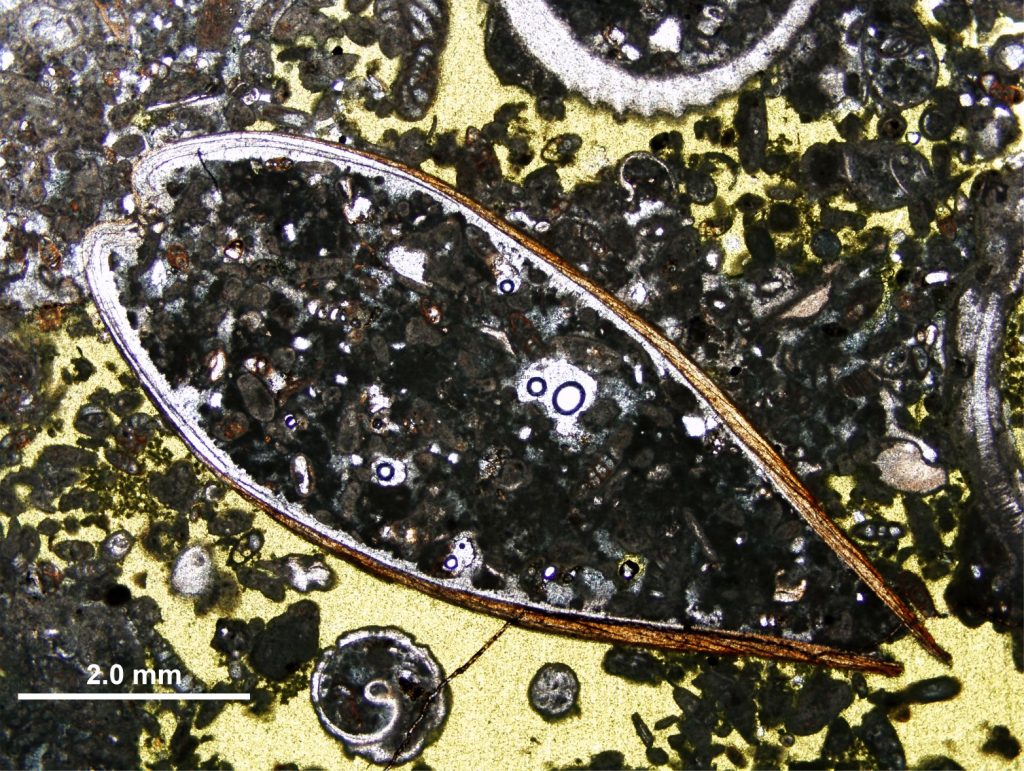
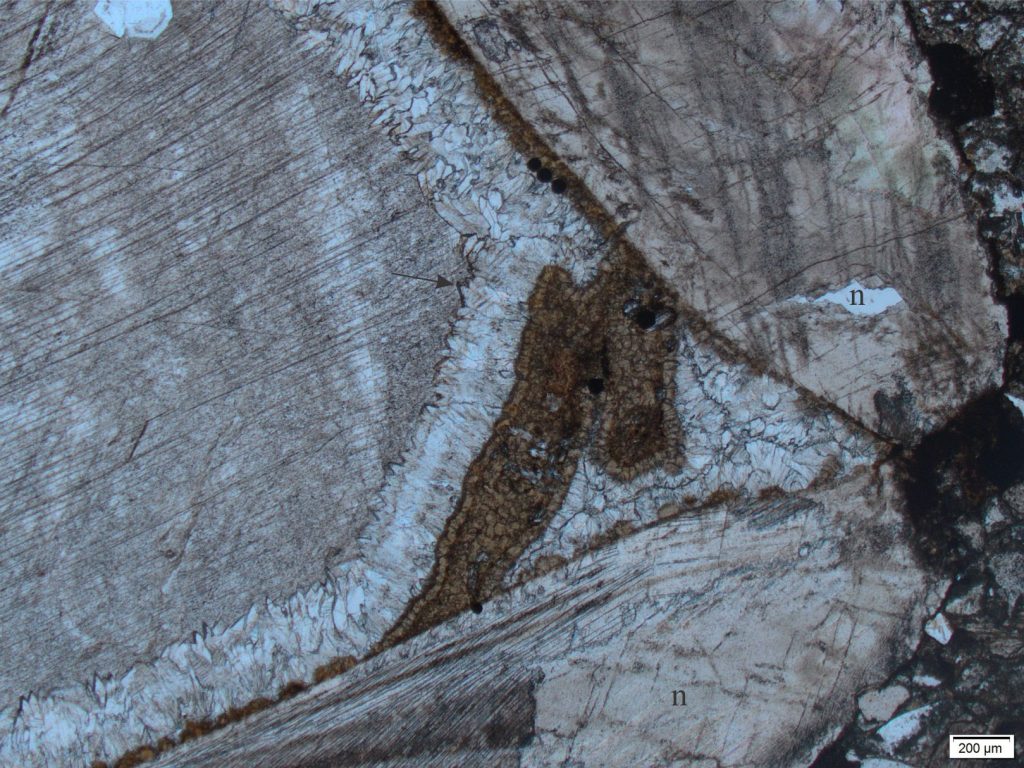
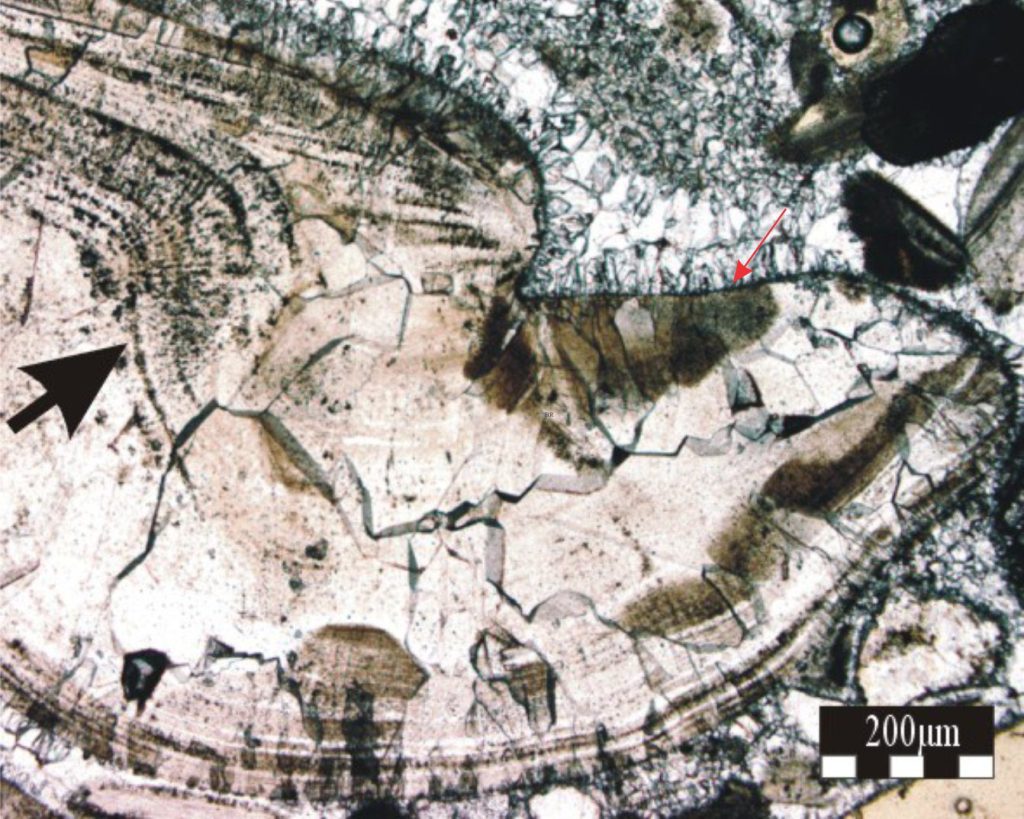
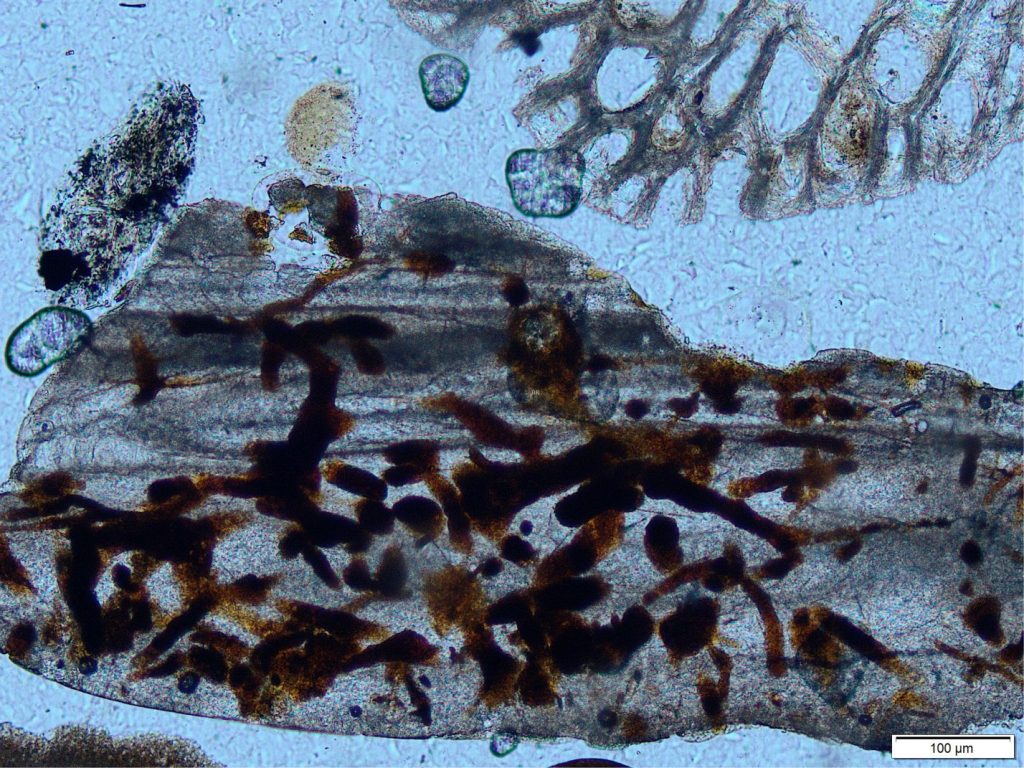
Gastropods
Whorls are arranged in corkscrew fashion around a central, solid column (the columella); longitudinal and oblique sections will show this arrangement. Transverse sections will show the columella. The gastropod spire, whether short or long, will be tapered. Whorls will be filled with sediment and/or cements.
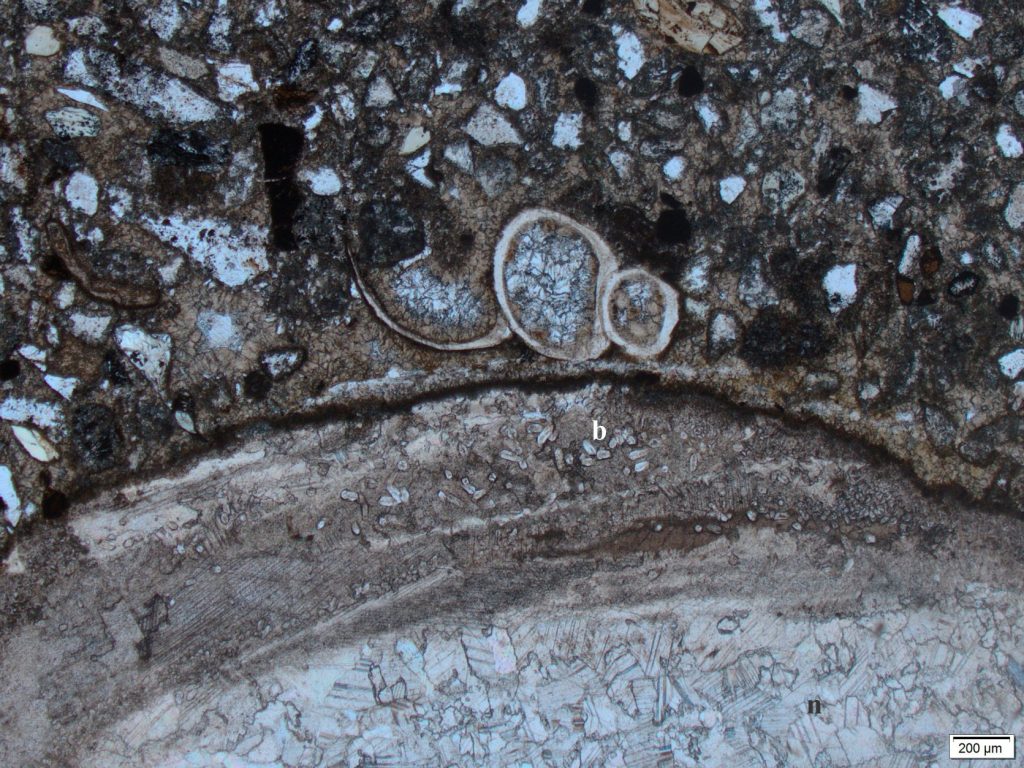
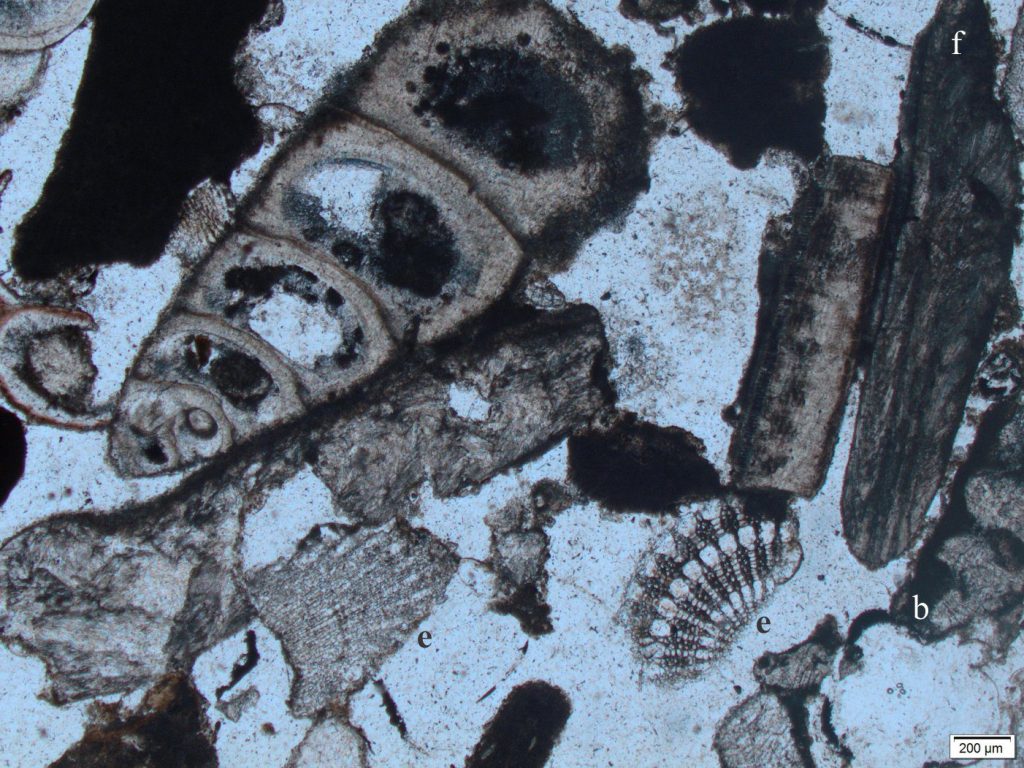
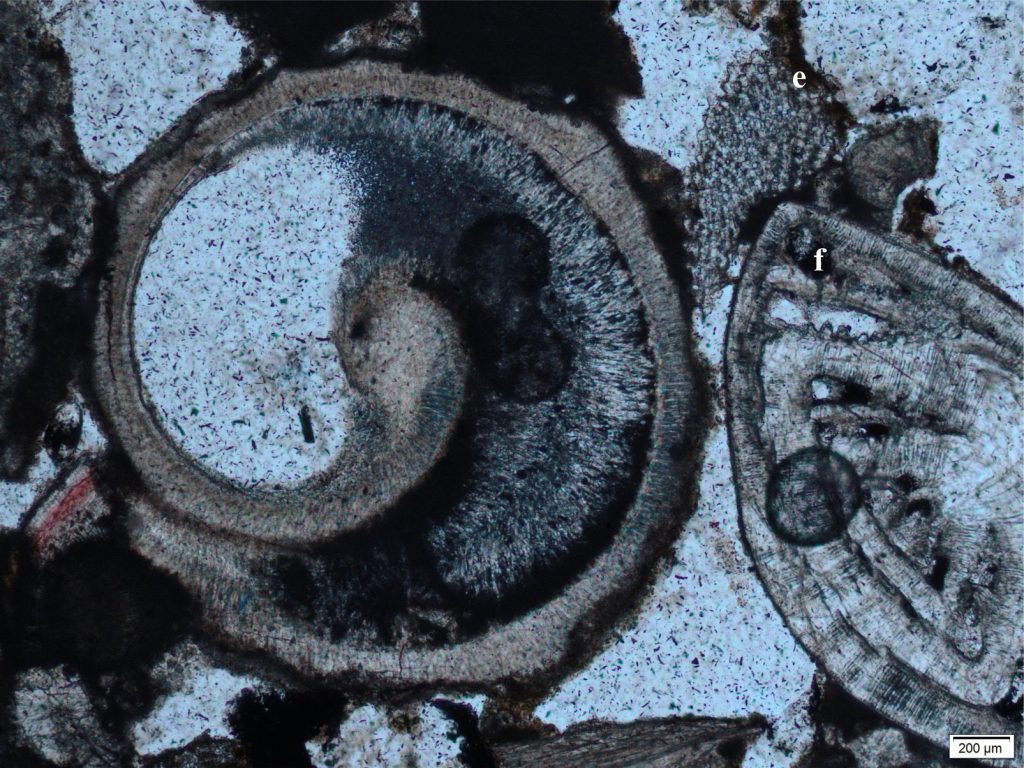
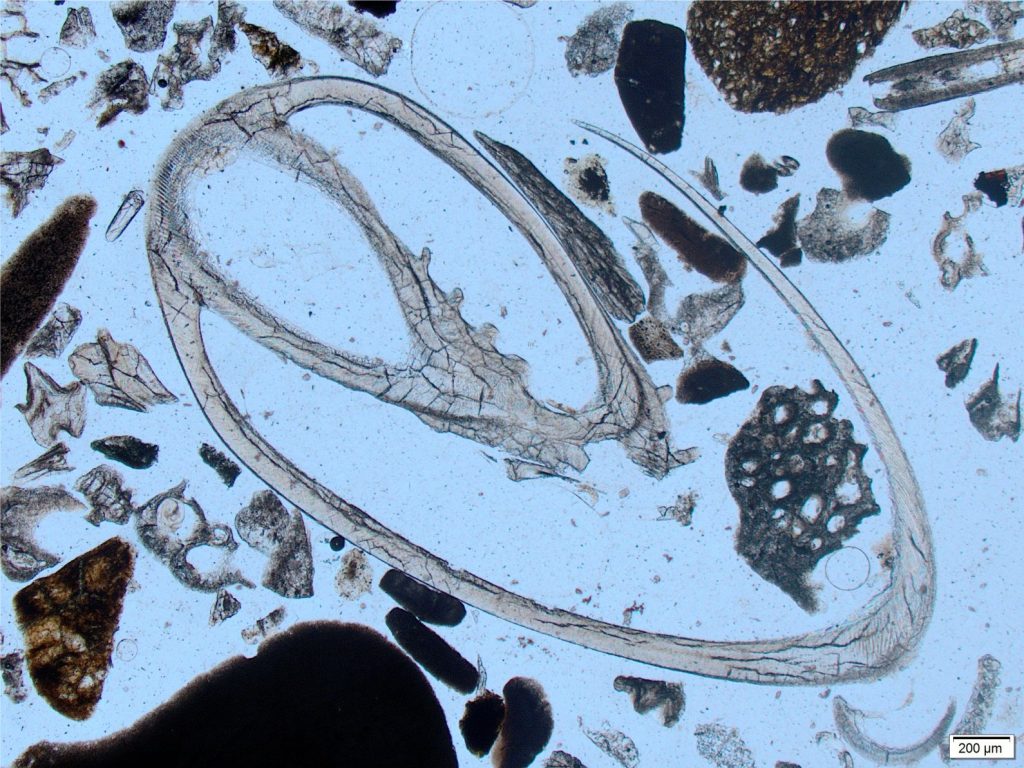
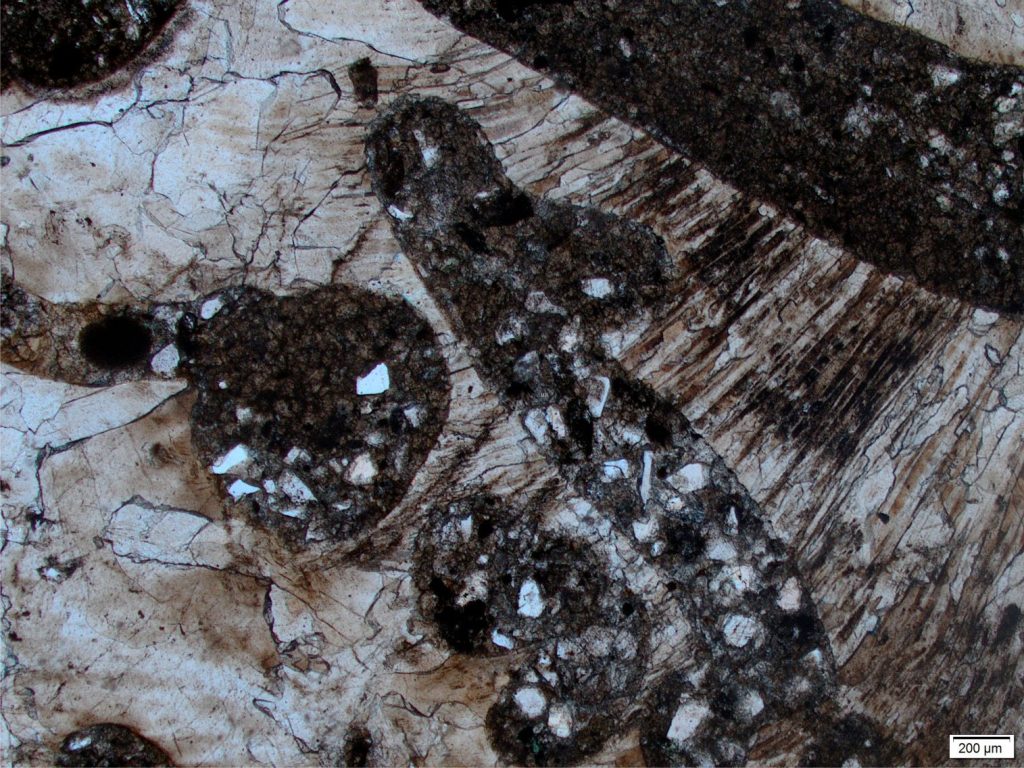
Scaphopods
Also known as tusk shells, are tapered longitudinally and hollow down the centre where the animal resides. Transverse sections show a circular shell outline; the shell is layered as in other molluscs, but calcite replacement of the aragonite may obscure the original layer structures. The central part of the shell is hollow and will fill with sediment and or cements. In life, the shells are open at both ends.
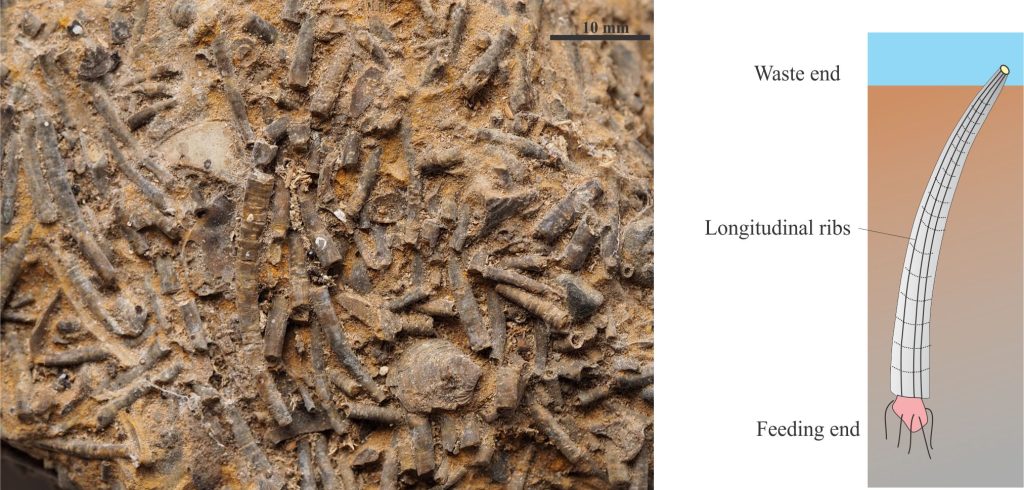
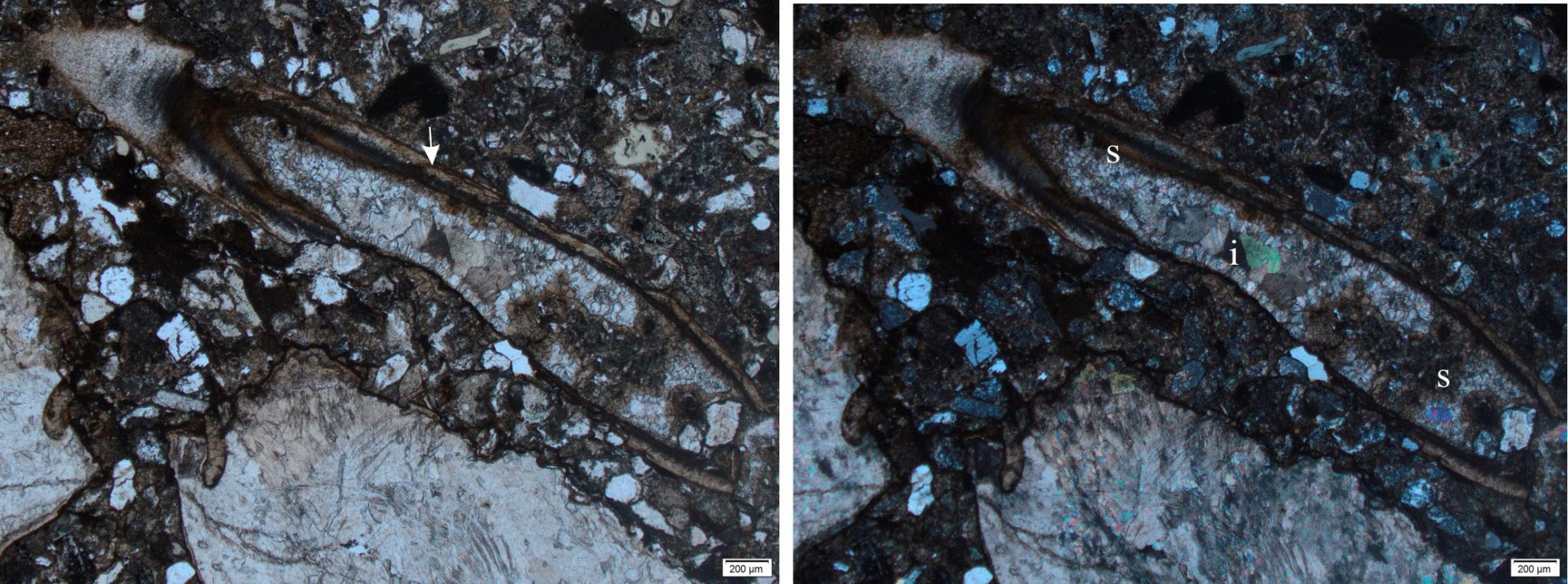
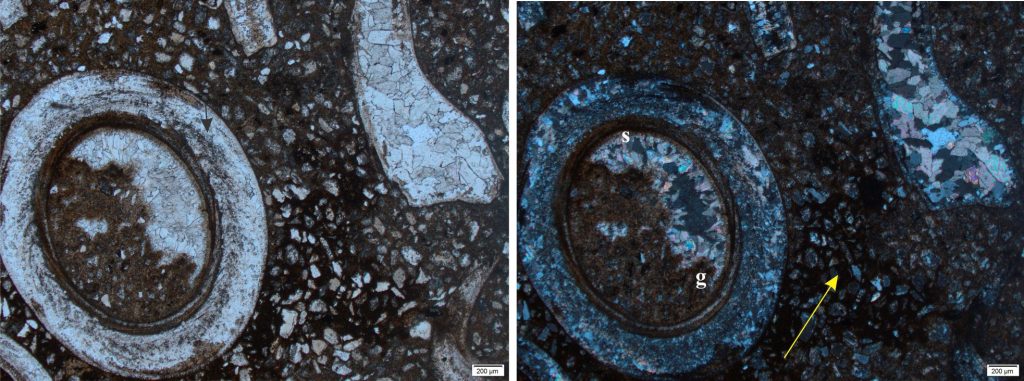
Distinguishing molluscs from other phyla
Brachiopods: Bivalved, shells always unequal but bilaterally symmetrical. Shells consist of calcite layers. Small fragments may be difficult to distinguish from molluscs, unless they contain punctae normal to the shell surface (punctae are tube-like perforations through the shell). Brachiopod shells are connected at a hinge but lack the dentition that is characteristic of bivalves.
Echinoderms: Echinoderm plates and spines consist of a single calcite crystal. Calcite cements are commonly syntaxial; this can be verified under crossed nicols where the plate (or spine) plus cement will move into extinction together. Plates and spines also contain micron-sized pores that will ultimately fill with syntaxial calcite cement, or minerals such as glauconite.
Barnacles: The interlaminate and plicate (fold) structures typical of barnacle plates (mostly low magnesium calcite) are diagnostic thin section features, even in small fragments. Individual plates may contain a mix of aragonite and calcite, unlike mollusc layers that are always monomineralic.
Foraminifera: Small gastropods sometimes resemble planispiral benthic forams. However, the chambers in forams are discrete and separate from their nearest neighbours; the body whorls in gastropods are continuous and arranged in corkscrew fashion around a central column.
Acknowledgement
Many thanks to Kirsty Vincent, Earth Sciences, Waikato University for access to the petrographic microscope.
Other posts in this series
Brachiopod morphology for sedimentologists
Bivalve shell morphology for sedimentologists
Gastropod shell morphology for sedimentologists
Cephalopod morphology for sedimentologists
Optical mineralogy: Some terminology
Carbonates in thin section: Echinoderms and barnacles
Carbonates in thin section: Bryozoa
Carbonates in thin section: Forams and sponges
Neomorphic textures in thin section
Mineralogy of carbonates; skeletal grains
Bivalve morphology for sedimentologists
Mineralogy of carbonates; non-skeletal grains
Mineralogy of carbonates; lime mud
Mineralogy of carbonates; classification
Mineralogy of carbonates; carbonate factories
Mineralogy of carbonates; basic geochemistry
Mineralogy of carbonates; cements
Mineralogy of carbonates; sea floor diagenesis
Mineralogy of carbonates; Beachrock
Mineralogy of carbonates; deep sea diagenesis
Mineralogy of carbonates; meteoric hydrogeology
Mineralogy of carbonates; Karst
Mineralogy of carbonates; Burial diagenesis
Mineralogy of carbonates; Neomorphism
